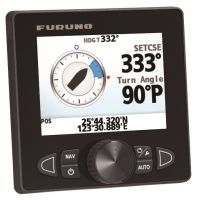The Autopilot
Autopilots on ships take over control according to a fixed course, according to a given route (waypoint list) or, in the case of sailing ships, according to the wind (wind vane control). On larger ships, they are integrated into a comprehensive electronic navigation system (ECDIS). The autopilot calculates the necessary course correction from various data sources. The steered course (compass course or course over ground) is measured, which is compared with the given course over ground. A control signal is generated from the difference, which acts mechanically or hydraulically on the steering system and causes the ship to change course via the rudder blade. Modern devices determine the course of the ship with a gyro compass or via GPS. They also take into account roll and pitch movements due to swell and gusts of wind, wind rotations, currents and changes in the earth's magnetic field. Routes can be entered via a waypoint list or by clicking directly on the nautical chart, which the autopilot then automatically follows. When a waypoint is reached, an (acoustic) information is given and the device automatically switches to the next waypoint.











